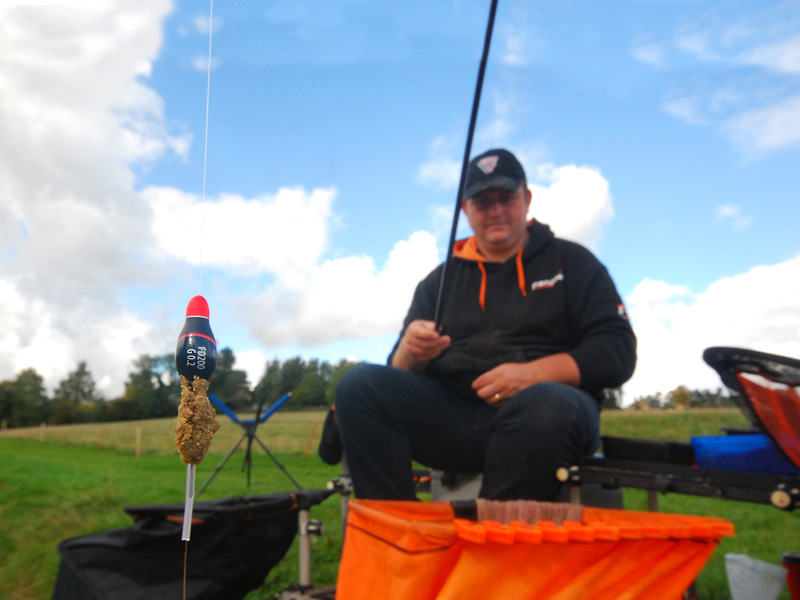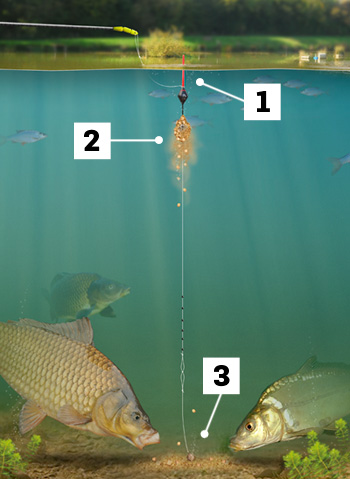Tie a pole float baggin' waggler
The baggin’ waggler is one of the best ways to enjoy consistent sport. The large, cigar-shaped floats with a small Method feeder attached to their base enable the angler to fish a hookbait in a column of feed.
If you use one of these beasts in the winter, though, you risk killing the swim. But by scaling down and using a pole float and a small bait coil, Dean Jones has created a rig more suitable to the demands of winter fishing.
Baggin’ wagglers have been around well over 25 years. The theory of fishing a hookbait through a tight column of falling loosefeed is relevant at all times of the year; it just needs to be scaled back in the colder months.
There are problems with other forms of loosefeeding. The pole pot is a one-shot deal – once the feed is fed, the pot is empty – and with a catapult, the loosefeed gets spread over a wide area. So when you need to keep loosefeed tight, neither is particularly appealing.
“To solve this problem I came up with the baggin’ pole float. By sliding a Korum bait spring on to the stem of a pole float, I created a mini baggin’ waggler. The results have been nothing short of brilliant,” said the Frenzee and Bag’em Match Baits-backed rod.
“I have found that I am now able to feed with great accuracy, and my hookbait can be fished hard on the deck or up in the water,” said Dean.
Dean’s pole float set-up
The beauty of Dean’s approach is that you can use whatever tackle you want, the only stipulation being that the pole float is large enough to cope with the extra weight of the additional loosefeed packed around its stem.
Dean recommends a float of at least 0.4g but 0.5g or larger is better, depending upon the amount of loosefeed you are planning to fish.
“In the depths of winter, I use a small coil and place a few shot down the line to trim the float correctly,” he explained.
“On milder days, like today, I dispense with the shot altogether and just use the loading of the feed to trim the rig. When all of the loosefeed has broken down, the float rises in the water, signposting that it is time to rebait the spring.”
To create the pole float baggin’ waggler, Dean follows the time-honoured way of making a pole float rig, only with a slight difference.
After threading on the silicone, he then slides a thicker tighter length of tubing on to the mainline, followed by the bait spring and then the pole float. The components are then pushed together. As for the rest of the rig, it is up to the angler to use components they’re are most happy with. Dean opts for Frenzee Vertex 0.15mm (4lb 13oz) mono that doesn’t kink under the strain of the ball of feed because it is thicker.
“I generally fish the mainline through to the hook, unless I’m targeting small carp or silverfish, when I will use a lighter hooklink.
“Hook size depends on the hookbait I am planning to use. Today I have a 6mm expander on the hook, to a size 16. If I was after silverfish, using a maggot hookbait for example, I might use a size 18,” said Dean.
The float’s loosefeed
For the all-important free feed, Dean reckons that groundbait is the best, with a few particles added to ‘match the hatch’.
The great thing about groundbait is that it creates a cloud that attracts fish but doesn’t feed them.
Plus, if you start with groundbait, it is almost impossible to overfeed the swim.
Yet if the fish are feeding confidently on the day, he will increase the amount of particle to crumb to help hold them in the swim for longer. For today’s session, he found a 70:30 mixture of groundbait and micro pellets was about right. Dean steers clear of Method mixes as they are too stodgy and do not break down nicely in the swim.
“I have found a 50:50 mixture of XP and Commercial Carp works best. The XP is used to create the bulk of the smell and cloud, the Commercial Carp for its binding power. If you do add particles – such as a few pellets – only put them in after the groundbait is correctly mixed to prevent them taking on water and expanding because they can stick in the spring’s coils.”
Once the bait is mixed, it is then a case of gauging the amount needed to load the float. That is the beauty of this rig; you don’t need pole pots or cups, as the baggin’ waggler action of the rig does everything for you.
“Like all matchmen, I am always on the lookout for that next edge that will help take my angling to a higher level. I can’t believe that no-one else has tried this before. It has certainly made a massive difference to my cold-water catches,” concluded Dean.
POLE FLOAT BAGGIN' WAG
1. Once the bait has fallen off the spring the float will rise in the water so you know it's time to refill it
2. The groundbait creates a cloud of attraction. A few pellets will help to hold the fish in the swim for longer
3. With this tactic the hookbait can either be fished up in the water or on the deck
Dean’s tackle
- Pole: Frenzee Precision FXT 16m Pole
- Elastic: Frenzee Stretch Hollow Elastic green
- Float: Frenzee
- Mainline: Frenzee Vertex 0.15mm (4lb 13oz)
- Hook: Frenzee 1420 Pattern size 16
- Loosefeed: Bag’em Matchbaits Commercial Carp, Bag’em Matchbaits XP groundbait
- Hookbaits: Bag’em Matchbaits Super Natural Carp Pellets 2mm, Bag’em Matchbaits Easy Xpanda pellets 6mm


